SKODA CITIGO 2015 1.G Repair Manual
Manufacturer: SKODA, Model Year: 2015, Model line: CITIGO, Model: SKODA CITIGO 2015 1.GPages: 160, PDF Size: 23.1 MB
Page 61 of 160
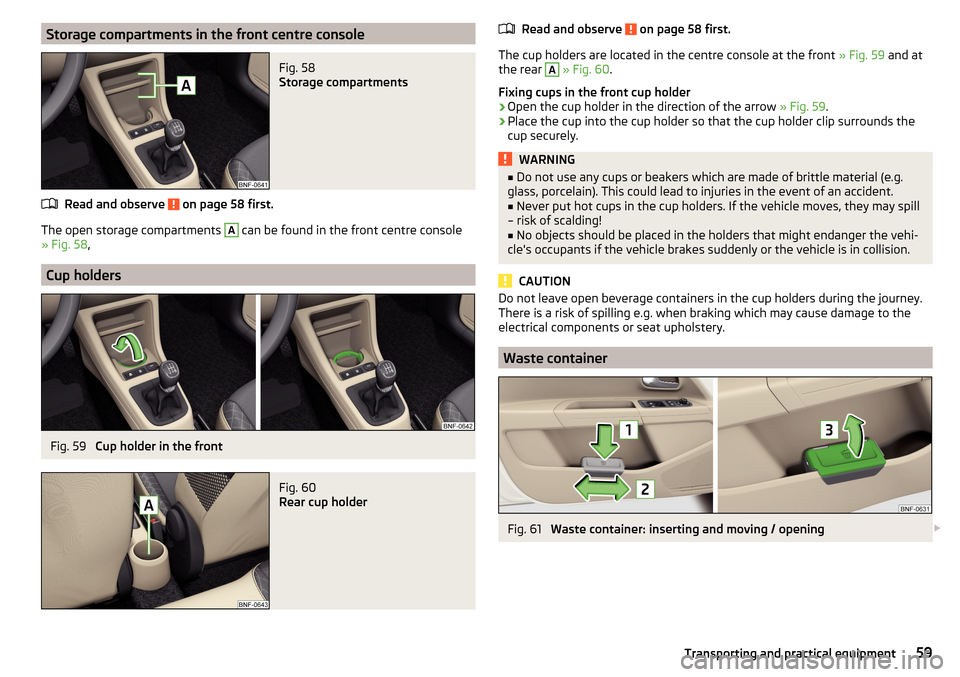
Storage compartments in the front centre consoleFig. 58
Storage compartments
Read and observe on page 58 first.
The open storage compartments
A
can be found in the front centre console
» Fig. 58 ,
Cup holders
Fig. 59
Cup holder in the front
Fig. 60
Rear cup holder
Read and observe on page 58 first.
The cup holders are located in the centre console at the front » Fig. 59 and at
the rear
A
» Fig. 60 .
Fixing cups in the front cup holder
›
Open the cup holder in the direction of the arrow » Fig. 59.
›
Place the cup into the cup holder so that the cup holder clip surrounds the
cup securely.
WARNING■ Do not use any cups or beakers which are made of brittle material (e.g.
glass, porcelain). This could lead to injuries in the event of an accident.■
Never put hot cups in the cup holders. If the vehicle moves, they may spill
– risk of scalding!
■
No objects should be placed in the holders that might endanger the vehi-
cle's occupants if the vehicle brakes suddenly or the vehicle is in collision.
CAUTION
Do not leave open beverage containers in the cup holders during the journey.
There is a risk of spilling e.g. when braking which may cause damage to the
electrical components or seat upholstery.
Waste container
Fig. 61
Waste container: inserting and moving / opening
59Transporting and practical equipment
Page 62 of 160
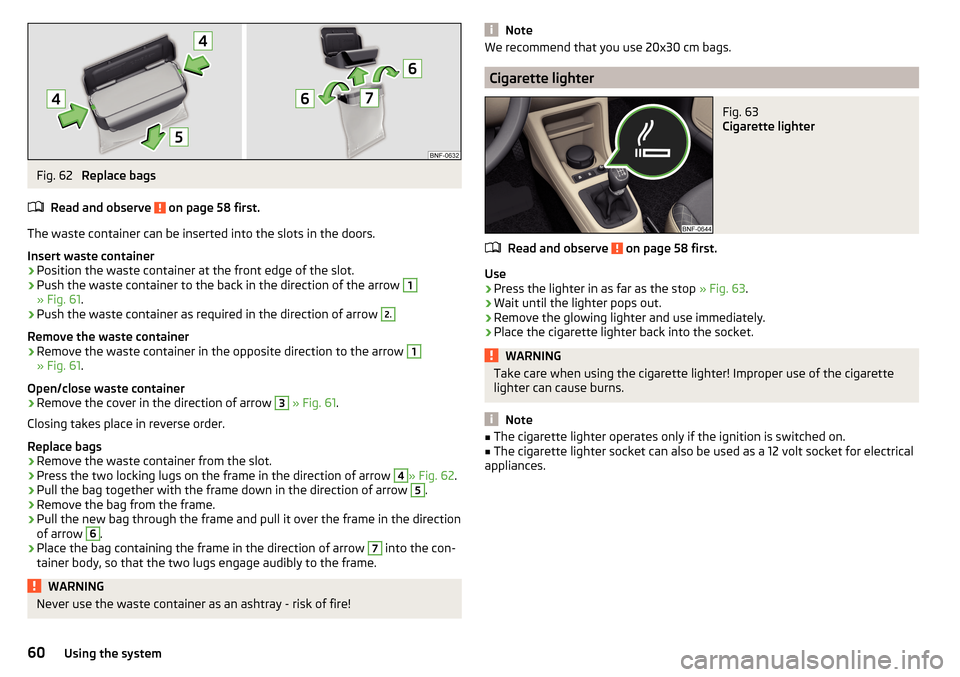
Fig. 62
Replace bags
Read and observe
on page 58 first.
The waste container can be inserted into the slots in the doors.
Insert waste container
›
Position the waste container at the front edge of the slot.
›
Push the waste container to the back in the direction of the arrow
1
» Fig. 61 .
›
Push the waste container as required in the direction of arrow
2.
Remove the waste container
›
Remove the waste container in the opposite direction to the arrow
1
» Fig. 61.
Open/close waste container
›
Remove the cover in the direction of arrow
3
» Fig. 61 .
Closing takes place in reverse order.
Replace bags
›
Remove the waste container from the slot.
›
Press the two locking lugs on the frame in the direction of arrow
4
» Fig. 62 .
›
Pull the bag together with the frame down in the direction of arrow
5
.
›
Remove the bag from the frame.
›
Pull the new bag through the frame and pull it over the frame in the direction
of arrow
6
.
›
Place the bag containing the frame in the direction of arrow
7
into the con-
tainer body, so that the two lugs engage audibly to the frame.
WARNINGNever use the waste container as an ashtray - risk of fire!NoteWe recommend that you use 20x30 cm bags.
Cigarette lighter
Fig. 63
Cigarette lighter
Read and observe on page 58 first.
Use
›
Press the lighter in as far as the stop » Fig. 63.
›
Wait until the lighter pops out.
›
Remove the glowing lighter and use immediately.
›
Place the cigarette lighter back into the socket.
WARNINGTake care when using the cigarette lighter! Improper use of the cigarette
lighter can cause burns.
Note
■ The cigarette lighter operates only if the ignition is switched on.■The cigarette lighter socket can also be used as a 12 volt socket for electrical
appliances.60Using the system
Page 63 of 160
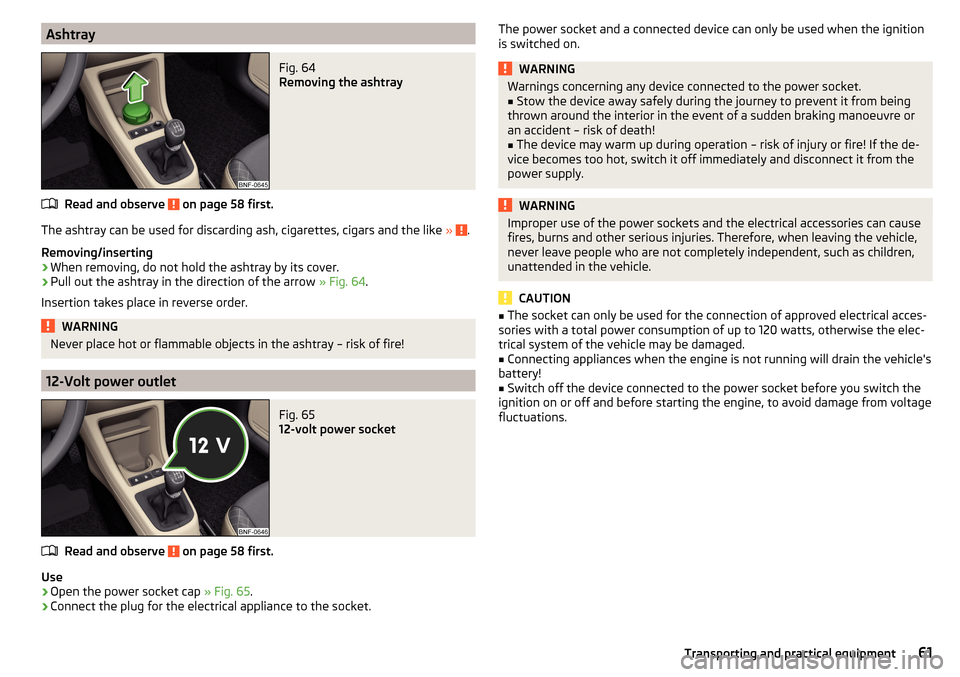
AshtrayFig. 64
Removing the ashtray
Read and observe on page 58 first.
The ashtray can be used for discarding ash, cigarettes, cigars and the like » .
Removing/inserting
›
When removing, do not hold the ashtray by its cover.
›
Pull out the ashtray in the direction of the arrow » Fig. 64.
Insertion takes place in reverse order.
WARNINGNever place hot or flammable objects in the ashtray – risk of fire!
12-Volt power outlet
Fig. 65
12-volt power socket
Read and observe on page 58 first.
Use
›
Open the power socket cap » Fig. 65.
›
Connect the plug for the electrical appliance to the socket.
The power socket and a connected device can only be used when the ignition
is switched on.WARNINGWarnings concerning any device connected to the power socket.■Stow the device away safely during the journey to prevent it from being
thrown around the interior in the event of a sudden braking manoeuvre or
an accident – risk of death!■
The device may warm up during operation – risk of injury or fire! If the de-
vice becomes too hot, switch it off immediately and disconnect it from the
power supply.
WARNINGImproper use of the power sockets and the electrical accessories can cause
fires, burns and other serious injuries. Therefore, when leaving the vehicle,
never leave people who are not completely independent, such as children,
unattended in the vehicle.
CAUTION
■ The socket can only be used for the connection of approved electrical acces-
sories with a total power consumption of up to 120 watts, otherwise the elec-
trical system of the vehicle may be damaged.■
Connecting appliances when the engine is not running will drain the vehicle's
battery!
■
Switch off the device connected to the power socket before you switch the
ignition on or off and before starting the engine, to avoid damage from voltage
fluctuations.
61Transporting and practical equipment
Page 64 of 160
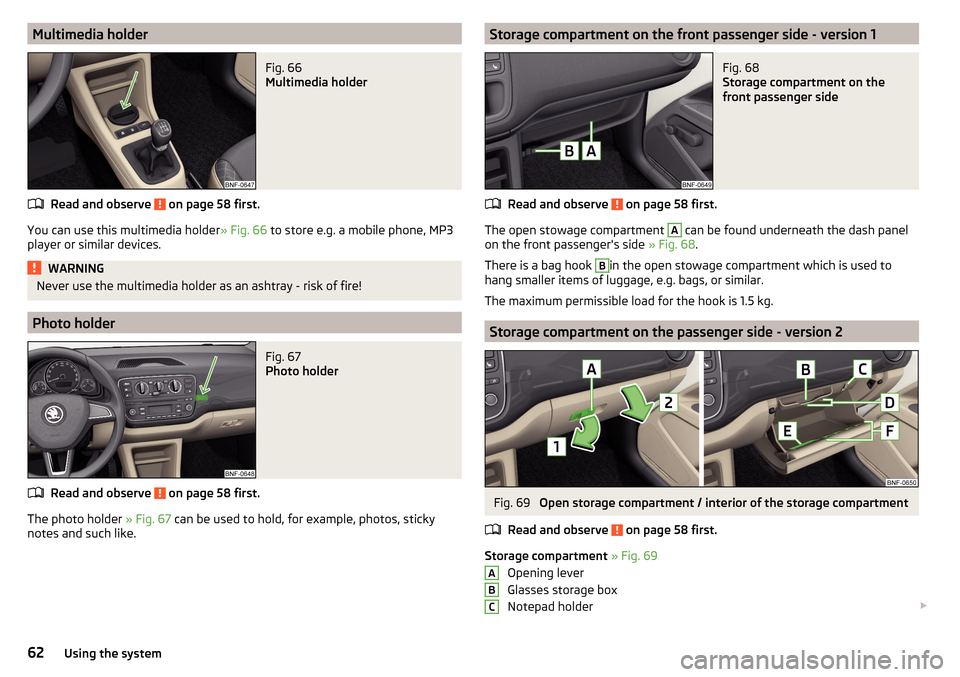
Multimedia holderFig. 66
Multimedia holder
Read and observe on page 58 first.
You can use this multimedia holder» Fig. 66 to store e.g. a mobile phone, MP3
player or similar devices.
WARNINGNever use the multimedia holder as an ashtray - risk of fire!
Photo holder
Fig. 67
Photo holder
Read and observe on page 58 first.
The photo holder » Fig. 67 can be used to hold, for example, photos, sticky
notes and such like.
Storage compartment on the front passenger side - version 1Fig. 68
Storage compartment on the
front passenger side
Read and observe on page 58 first.
The open stowage compartment
A
can be found underneath the dash panel
on the front passenger's side » Fig. 68.
There is a bag hook
B
in the open stowage compartment which is used to
hang smaller items of luggage, e.g. bags, or similar.
The maximum permissible load for the hook is 1.5 kg.
Storage compartment on the passenger side - version 2
Fig. 69
Open storage compartment / interior of the storage compartment
Read and observe
on page 58 first.
Storage compartment » Fig. 69
Opening lever
Glasses storage box
Notepad holder
ABC62Using the system
Page 65 of 160
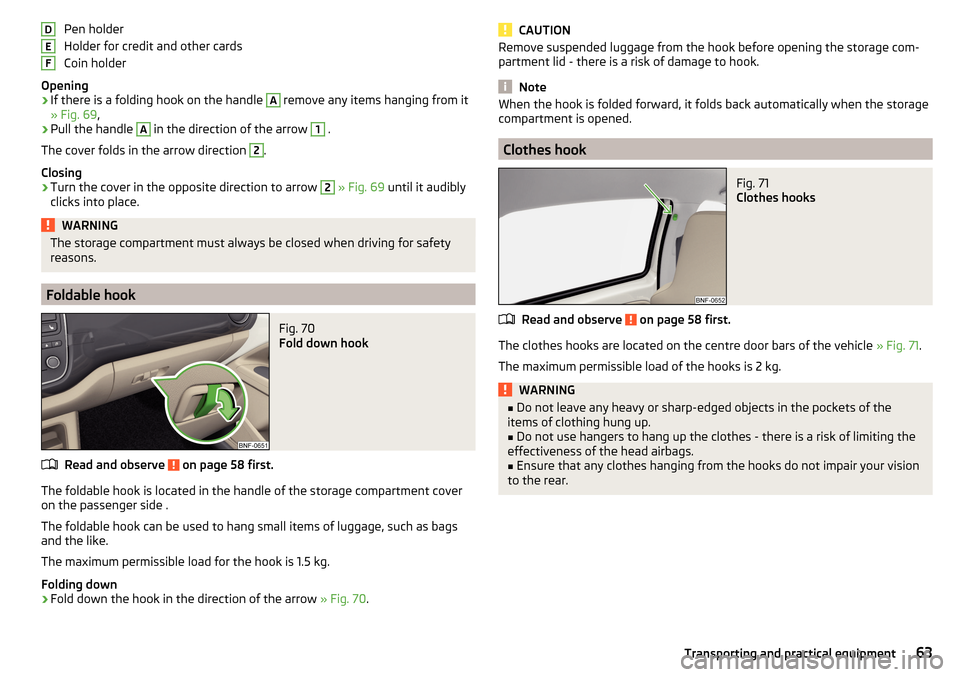
Pen holder
Holder for credit and other cards
Coin holder
Opening›
If there is a folding hook on the handle
A
remove any items hanging from it
» Fig. 69 ,
›
Pull the handle
A
in the direction of the arrow
1
.
The cover folds in the arrow direction
2
.
Closing
›
Turn the cover in the opposite direction to arrow
2
» Fig. 69 until it audibly
clicks into place.
WARNINGThe storage compartment must always be closed when driving for safety
reasons.
Foldable hook
Fig. 70
Fold down hook
Read and observe on page 58 first.
The foldable hook is located in the handle of the storage compartment cover
on the passenger side .
The foldable hook can be used to hang small items of luggage, such as bags
and the like.
The maximum permissible load for the hook is 1.5 kg.
Folding down
›
Fold down the hook in the direction of the arrow » Fig. 70.
DEFCAUTIONRemove suspended luggage from the hook before opening the storage com-
partment lid - there is a risk of damage to hook.
Note
When the hook is folded forward, it folds back automatically when the storage
compartment is opened.
Clothes hook
Fig. 71
Clothes hooks
Read and observe on page 58 first.
The clothes hooks are located on the centre door bars of the vehicle » Fig. 71.
The maximum permissible load of the hooks is 2 kg.
WARNING■ Do not leave any heavy or sharp-edged objects in the pockets of the
items of clothing hung up.■
Do not use hangers to hang up the clothes - there is a risk of limiting the
effectiveness of the head airbags.
■
Ensure that any clothes hanging from the hooks do not impair your vision
to the rear.
63Transporting and practical equipment
Page 66 of 160
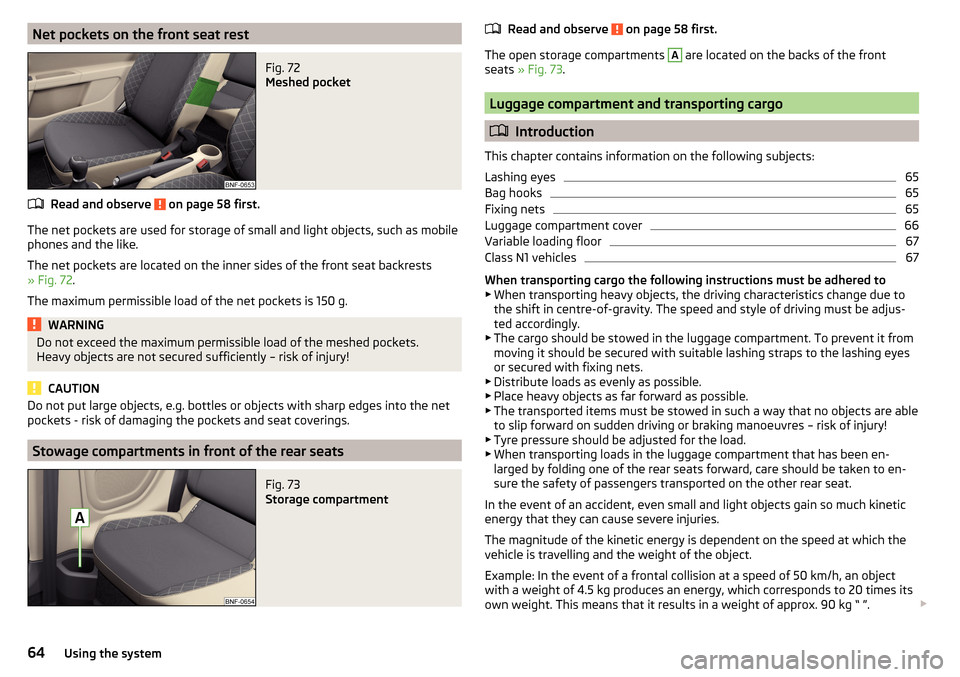
Net pockets on the front seat restFig. 72
Meshed pocket
Read and observe on page 58 first.
The net pockets are used for storage of small and light objects, such as mobilephones and the like.
The net pockets are located on the inner sides of the front seat backrests
» Fig. 72 .
The maximum permissible load of the net pockets is 150 g.
WARNINGDo not exceed the maximum permissible load of the meshed pockets.
Heavy objects are not secured sufficiently – risk of injury!
CAUTION
Do not put large objects, e.g. bottles or objects with sharp edges into the net
pockets - risk of damaging the pockets and seat coverings.
Stowage compartments in front of the rear seats
Fig. 73
Storage compartment
Read and observe on page 58 first.
The open storage compartments
A
are located on the backs of the front
seats » Fig. 73 .
Luggage compartment and transporting cargo
Introduction
This chapter contains information on the following subjects:
Lashing eyes
65
Bag hooks
65
Fixing nets
65
Luggage compartment cover
66
Variable loading floor
67
Class N1 vehicles
67
When transporting cargo the following instructions must be adhered to
▶ When transporting heavy objects, the driving characteristics change due to
the shift in centre-of-gravity. The speed and style of driving must be adjus-
ted accordingly.
▶ The cargo should be stowed in the luggage compartment. To prevent it from
moving it should be secured with suitable lashing straps to the lashing eyes
or secured with fixing nets.
▶ Distribute loads as evenly as possible.
▶ Place heavy objects as far forward as possible.
▶ The transported items must be stowed in such a way that no objects are able
to slip forward on sudden driving or braking manoeuvres – risk of injury!
▶ Tyre pressure should be adjusted for the load.
▶ When transporting loads in the luggage compartment that has been en-
larged by folding one of the rear seats forward, care should be taken to en-
sure the safety of passengers transported on the other rear seat.
In the event of an accident, even small and light objects gain so much kinetic
energy that they can cause severe injuries.
The magnitude of the kinetic energy is dependent on the speed at which the
vehicle is travelling and the weight of the object.
Example: In the event of a frontal collision at a speed of 50 km/h, an object
with a weight of 4.5 kg produces an energy, which corresponds to 20 times its
own weight. This means that it results in a weight of approx. 90 kg “ ”.
64Using the system
Page 67 of 160
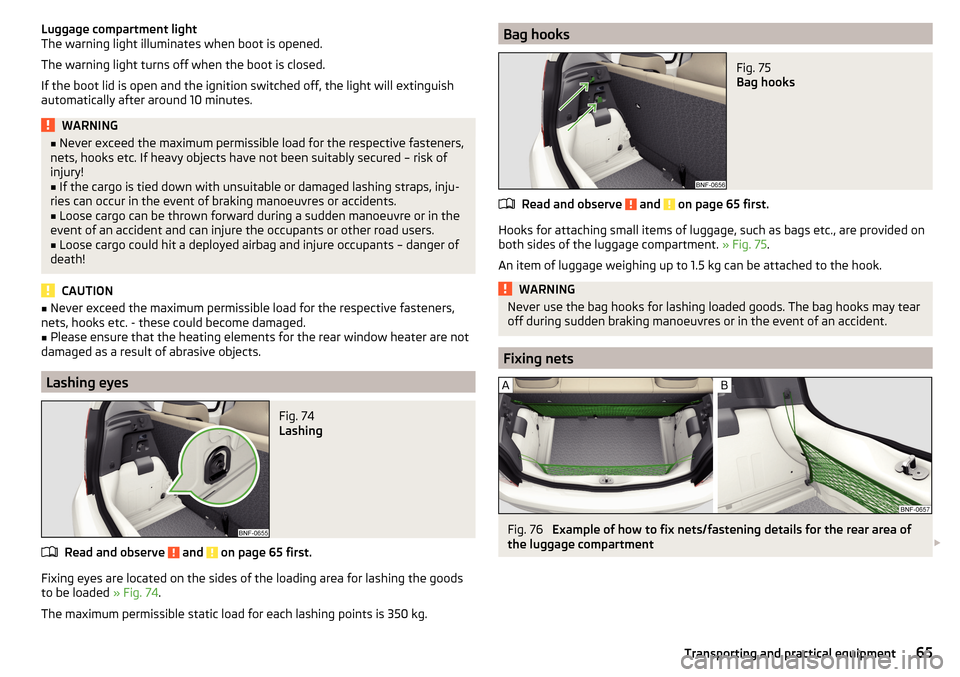
Luggage compartment light
The warning light illuminates when boot is opened.
The warning light turns off when the boot is closed.
If the boot lid is open and the ignition switched off, the light will extinguish
automatically after around 10 minutes.WARNING■ Never exceed the maximum permissible load for the respective fasteners,
nets, hooks etc. If heavy objects have not been suitably secured – risk of
injury!■
If the cargo is tied down with unsuitable or damaged lashing straps, inju-
ries can occur in the event of braking manoeuvres or accidents.
■
Loose cargo can be thrown forward during a sudden manoeuvre or in the
event of an accident and can injure the occupants or other road users.
■
Loose cargo could hit a deployed airbag and injure occupants – danger of
death!
CAUTION
■ Never exceed the maximum permissible load for the respective fasteners,
nets, hooks etc. - these could become damaged.■
Please ensure that the heating elements for the rear window heater are not
damaged as a result of abrasive objects.
Lashing eyes
Fig. 74
Lashing
Read and observe and on page 65 first.
Fixing eyes are located on the sides of the loading area for lashing the goods to be loaded » Fig. 74.
The maximum permissible static load for each lashing points is 350 kg.
Bag hooksFig. 75
Bag hooks
Read and observe and on page 65 first.
Hooks for attaching small items of luggage, such as bags etc., are provided on
both sides of the luggage compartment. » Fig. 75.
An item of luggage weighing up to 1.5 kg can be attached to the hook.
WARNINGNever use the bag hooks for lashing loaded goods. The bag hooks may tear
off during sudden braking manoeuvres or in the event of an accident.
Fixing nets
Fig. 76
Example of how to fix nets/fastening details for the rear area of
the luggage compartment
65Transporting and practical equipment
Page 68 of 160

Fig. 77
Details of the fastening behind the rear seats
Read and observe
and on page 65 first.
Fixing the nets » Fig. 76 and » Fig. 77
cross bags
Fastening details in the rear area of the luggage compartment
Details of the fastening to the upper lashing eyes behind the foldable rear
seat rest
Details of the fastening to the lashing eyes on the luggage compartment
floor behind the rear seats
The maximum permissible load of the fixing nets is 1.5 kg.
CAUTION
Do not place any sharp objects in the nets – risk of net damage.
Luggage compartment cover
Fig. 78
Removing/installing the luggage compartment cover
Read and observe and on page 65 first.
If the support straps
A
» Fig. 78 are attached to the boot lid, then opening the
lid will raise the boot lid cover (hereafter referred to as cover).
The cover can be removed if you wish to transport bulky goods.
Fold up and lock
›
Fold up the cover.
›
Lock the cover in the brackets
C
» Fig. 78 .
Unlocking
›
Fold the raised cover down.
The cover is released from the brackets
C
» Fig. 78 .
Removal
›
On both sides of the boot lid unhook the straps
A
in the direction of the ar-
row » Fig. 78 .
›
Tap on the lower part of the cover to release it from the brackets
C
and re-
move it from the vehicle.
Fitting
›
Place the cover on the brackets
B
» Fig. 78 and tap on the upper surface of
the cover to lock it into the brackets.
›
On both sides of the boot lid unhook the straps
A
.
WARNING■ No objects should be placed on the cover. This could endanger the vehicle
occupants during sudden braking or vehicle impact.■
Never ride with folded up cover.
66Using the system
Page 69 of 160
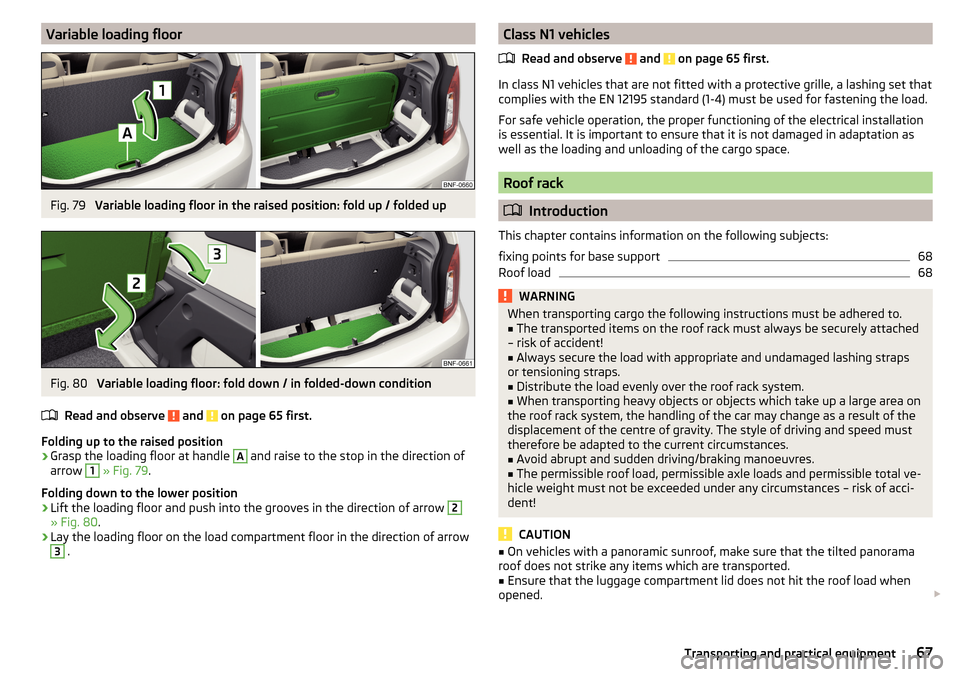
Variable loading floorFig. 79
Variable loading floor in the raised position: fold up / folded up
Fig. 80
Variable loading floor: fold down / in folded-down condition
Read and observe
and on page 65 first.
Folding up to the raised position
›
Grasp the loading floor at handle
A
and raise to the stop in the direction of
arrow
1
» Fig. 79 .
Folding down to the lower position
›
Lift the loading floor and push into the grooves in the direction of arrow
2
» Fig. 80 .
›
Lay the loading floor on the load compartment floor in the direction of arrow
3
.
Class N1 vehicles
Read and observe
and on page 65 first.
In class N1 vehicles that are not fitted with a protective grille, a lashing set that
complies with the EN 12195 standard (1-4) must be used for fastening the load.
For safe vehicle operation, the proper functioning of the electrical installation
is essential. It is important to ensure that it is not damaged in adaptation as
well as the loading and unloading of the cargo space.
Roof rack
Introduction
This chapter contains information on the following subjects:
fixing points for base support
68
Roof load
68WARNINGWhen transporting cargo the following instructions must be adhered to.■The transported items on the roof rack must always be securely attached
– risk of accident!■
Always secure the load with appropriate and undamaged lashing straps
or tensioning straps.
■
Distribute the load evenly over the roof rack system.
■
When transporting heavy objects or objects which take up a large area on
the roof rack system, the handling of the car may change as a result of the
displacement of the centre of gravity. The style of driving and speed must
therefore be adapted to the current circumstances.
■
Avoid abrupt and sudden driving/braking manoeuvres.
■
The permissible roof load, permissible axle loads and permissible total ve-
hicle weight must not be exceeded under any circumstances – risk of acci-
dent!
CAUTION
■ On vehicles with a panoramic sunroof, make sure that the tilted panorama
roof does not strike any items which are transported.■
Ensure that the luggage compartment lid does not hit the roof load when
opened.
67Transporting and practical equipment
Page 70 of 160
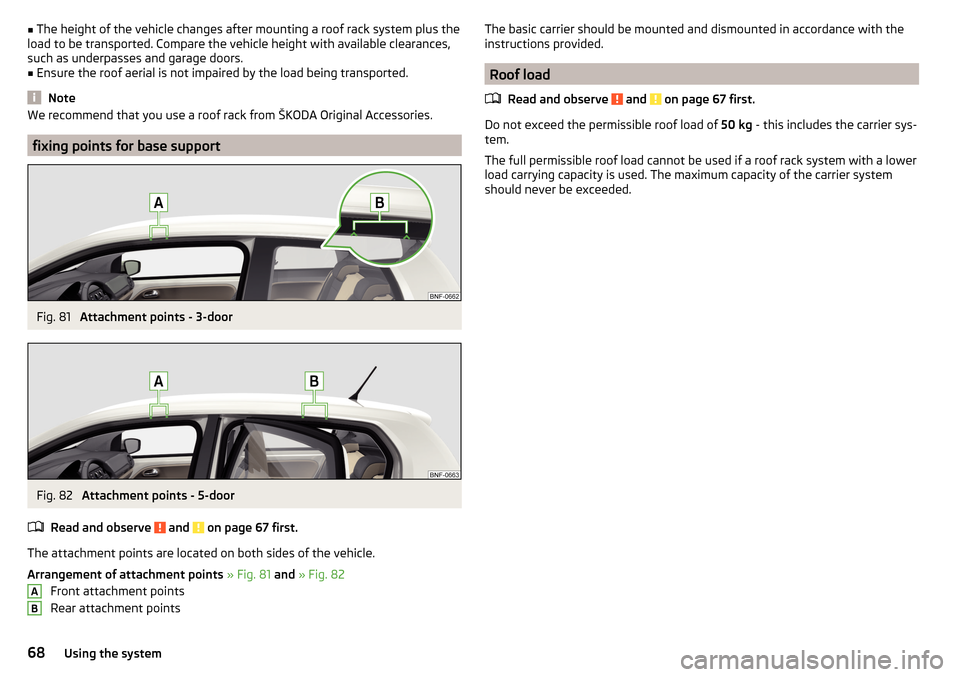
■The height of the vehicle changes after mounting a roof rack system plus the
load to be transported. Compare the vehicle height with available clearances,
such as underpasses and garage doors.■
Ensure the roof aerial is not impaired by the load being transported.
Note
We recommend that you use a roof rack from ŠKODA Original Accessories.
fixing points for base support
Fig. 81
Attachment points - 3-door
Fig. 82
Attachment points - 5-door
Read and observe
and on page 67 first.
The attachment points are located on both sides of the vehicle.
Arrangement of attachment points » Fig. 81 and » Fig. 82
Front attachment points
Rear attachment points
ABThe basic carrier should be mounted and dismounted in accordance with the
instructions provided.
Roof load
Read and observe
and on page 67 first.
Do not exceed the permissible roof load of 50 kg - this includes the carrier sys-
tem.
The full permissible roof load cannot be used if a roof rack system with a lower
load carrying capacity is used. The maximum capacity of the carrier system
should never be exceeded.
68Using the system